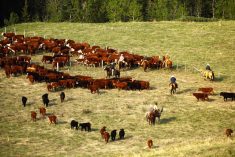Cattle pregnancy loss occurs for many reasons. Knowing about it can help you manage it and reduce it.
“Pregnancy loss occurs throughout all stages of gestation — it’s sort of a natural selection,” veterinarian Steve Hendrick of Coaldale Veterinary Services said during a recent Beef Cattle Research Council webinar.
“There are lots of genetic and developmental defects that can occur, and some of those are lethal and some pregnancies are lost very early.”
Improved technology allows pregnancies to be detected earlier, which has helped the industry to realize how common pregnancy loss is — although the causes still aren’t very easy to diagnose. About two to three per cent of pregnancies end with early embryonic loss, abortion, or stillbirths.
Read Also

Mosquito-borne virus could be devastating to sheep breeding operations
Cache Valley virus, a mosquito-borne disease that infects small ruminants, could be a devastating hit to small operations.
“A common sign of pregnancy loss is too many cows open at preg check,” said Hendrick. “Your vet may comment that there are quite a few cows that are dirty or have pus in the uterus. If they’ve lost their pregnancy early, what remains is some of the decaying debris from the fetus.”
If the fetus is younger than one month, it can be reabsorbed back into the cow’s body, and the cow will continue into her next menstrual cycle.
“Some of those cows, when you see them cycle back and you wonder if the bull is working — there could be early embryonic loss. It could be good to make a note and watch that.”
Fertilization rates are estimated at around 90 per cent. Common causes of pregnancy loss include trichomoniasis, vibriosis, bovine respiratory disease, and genetic and developmental defects. Cows can also miscarry in breeding season when there is a lot of heat stress on the animals. Pregnancy loss can occur when the cow has a nutritional deficiency or a disease that causes fever.
Heifers are more likely to have stillborn calves, due to the proportion of the calf’s weight in regards to the size of the heifer.
“We see more stillbirths if the cows are overconditioned or severely underconditioned,” said Hendrick. “In my experience, we see more stillbirths in cold winters. The feed intake of the cows can be greater, so we get more fetal growth and as a result, they tend to have slightly larger calves that can result in more difficult calvings.”
Malpresentation (when a calf emerges with the head back or a leg back) can result in a higher number of stillbirths.
If you’re only losing one calf a year, it’s nothing to get too excited about.
“If you start losing more, it deserves a phone call to the vet to give them a heads-up and discuss potential answers to what you are seeing,” said Hendrick, adding it’s helpful to record age, sire or dam, stage of pregnancy, and how they were managed.
In order to get a diagnostic test, call the lab or have your vet call the lab and let them know the sample is coming. Collect samples, which can include the fetus and the placenta. Blood samples, taken close to the time of abortion, as well as a couple of weeks later, can also be helpful to the lab. The samples should be double bagged, and packed on ice, but not frozen.
Testing labs generally only find a cause in one out of three abortion cases.
“Maybe that doesn’t sound good, but it’s better than not knowing,” said Hendrick.
According to records from Prairie Diagnostic Services in Saskatoon on bovine abortions from 2004-13, about half of the abortions were caused by bacteria and 30 per cent were caused by viruses. The remainder were caused by protozoa or fungal infection.
Non-infectious abortions can be related to poor nutrition or contaminated feed.
“Don’t forget, even if you’ve got mouldy bedding, they can inhale that and that too can spread to their uterus and cause infection through the blood,” said Hendrick.
Mycotoxins from ergot and fusarium and nitrates in cereals can also cause abortions.
“If you’re feeding cereals that have had frost, it would be worth it to do some testing to see what the nitrate levels are if you’re going to be using that as winter feed,” said Hendrick.
Narrow chutes and rough handling could also be a factor.
“We have to realize that we’re often stressing these animals at the same time as we are processing them or doing painful procedures to these animals. It’s often multifactorial,” he said.
















